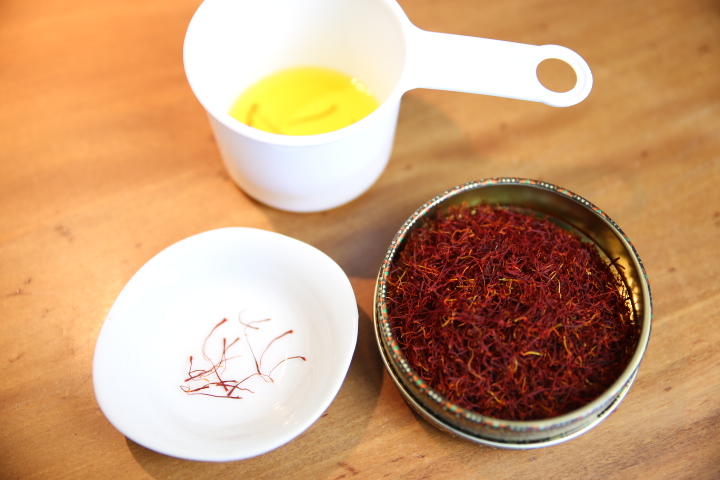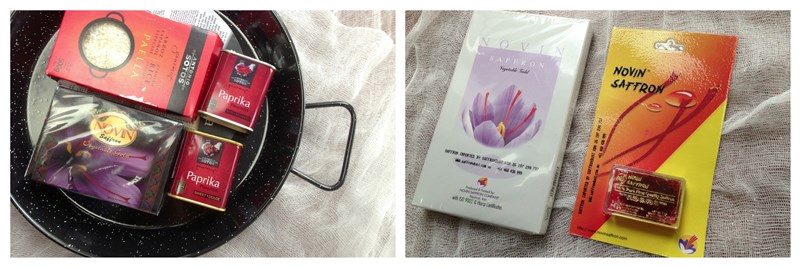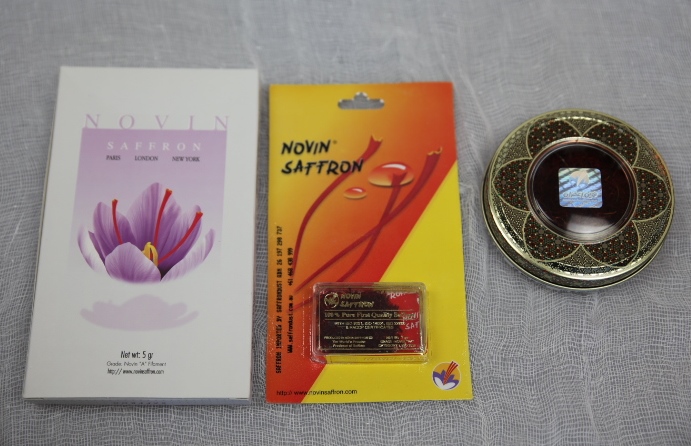Product Review: Novin Saffron threads from Saffrondust

This post has been sponsored by Saffrondust
 Saffron is considered the world's most expensive spice, and I was recently asked to review the saffron on offer at Saffrondust, an Australian importer and retailer of a range of quality saffron from Iran, Spain and Australia.
Saffron is considered the world's most expensive spice, and I was recently asked to review the saffron on offer at Saffrondust, an Australian importer and retailer of a range of quality saffron from Iran, Spain and Australia.
I tested their Novin brand saffron threads (filaments) which are their highest grade. We tried it in a tea, with rice and in a pilaf. In addition to cooking, saffron also has some amazing health claims so I have also decided to review the mounting case for including saffron in my list of Super Foods.
Taste: 10/10
I called for help from a colleague as I had never used saffron before thinking it was complicated and too expensive (which in hindsight was really out of lack of knowledge of the spice). Together we did three taste tests, one on saffron tea, the second adding the saffron to rice and thirdly making a saffron chicken pilaf. She loved the Novin saffron for flavour, colour and appearance and gave it a faultless rating of 10 out of 10. See here and here
Nutrition: 18/20
I've divided the nutrition score into two parts:
1. Nutritional Content
Like all spices and herbs, the quantities of saffron used in cooking or tea are so small that it probably contributes little in the way of nutrition.
It is, however, very concentrated and the USDA Food Database reports substantial levels of fibre, vitamin C, pyridoxine, folate and riboflavin, beta-carotene and the minerals manganese, magnesium, potassium and iron.
It appears that even tiny quantities eaten regularly may prove useful. Professor Jonathon Stone, Professor of Neurobiology at the University of Sydney, has published research which suggests that these small quantities, as little as 20mg per day, interact at the genetic level to turn on specific human genes which are capable of cell restoration.
2. Health/Medical Claims
Saffron (Crocus sativus) has been used for over 3000 years by many ancient cultures, including the Sumerians, Phoenicians, Minoans, Egyptians, Greeks, Romans and Persians.
Its medicinal uses are legendary and in times past it has been used to treat a whole range of health problems from coughs and common colds to scarlet fever, small pox, cancer, asthma, heart disease, gout, baby colic and even eye disorders.
having worked for McCormicks, I thought I knew a little about the health benefits of spices but I was taken aback by the range of claims for saffron, most of which are backed up by references.
It may certainly have anti-ageing properties as do many of the spices such as turmeric. There is mounting research that saffron's golden colour can hold back macula degeneration (loss of eyesight) in older years.
Saffron may protect the photoreceptors in the retina of the eye from damage, maintaining both their shape and function. It is thought that it may work through a protective mechanism similar to that seen with carotenoid supplements, says the Macula Society.
Other research has found saffron to be helpful in dementia treatment (Akhondzadeh, 2010), as effective an antidepressant such as Prozac without the side effects (Beauchamp, 2005; Akhondzadeh, 2007), and as a serotonin re-uptake inhibitor in treatments for addiction including opiate withdrawal (Hosseinzadeh & Jahanian, 2010) and hunger cravings (Gout et al, 2010).
Convenience: 6/10

Then you add the lovely golden water to your rice or pot. However once you get used to doing that, it's pretty easy. Just store the threads in a cool dry cupboard in a well-sealed jar or tin and use within six months.
According to Herbie, the Australian spice expert, it's best to buy quality dried threads (whole stigma) instead of powdered saffron since the powder is easier to adulterate and is impossible to detect. However, you can simply crush the threads between two spoons to create your own "powder".
- Look for saffron with long threads that have a bright red hue.
- Avoid anything with grey streaks or patchy spots which are signs of inferior quality. It should have a "pleasant floral aroma with a pungent bitter-honey taste" according to Herbie.
The Novin saffron I tested matched these descriptions.
Sustainability: 8/10
Most of Saffrondust's saffron is imported – mainly from Iran (Persia), renowned for its high-quality product, but also from Spain. Like many spices, certain regions have become known for growing the world's best products and this rings true of Iranian saffron. However, Saffrondust also offers an Australian-grown saffron for sale from Capertee, which is on the road to Mudgee in NSW.
According to Saffrondust, production of saffron in Iran makes the best use of harsh desert lands that would otherwise be arid. It is an autumn crop, that grows in the off season and so does not compete for water with other crops. In summer, the fields are rotated with sheep. It is not genetically modified as it grows from bulbs, not seeds.
Persian saffron is grown mostly on co-operative or family-owned farms in low socio-economic communities. Due to its labour intensive cultivation and production processes, it is a high contributor to employment (Kafi & Showket, 2001).
Organic fertilisers (mostly cow manure) are used together with traditional hand planting and harvesting techniques, but it is not certified organic because it's grown on low capital family or community farms. However, it complies with the general principles of organic production.
This is echoed by a 2006 report from agri-economic researchers Ghorbani & Koosheki, who say:
"No other crop can be as environmentally friendly, economically feasible and socially justified in the saffron growing areas and therefore it is a crop of sustainable values." And the Iranian saffron industry is "organic by neglect".
The bottom line
Saffron certainly ticks all the boxes for me and I know I'll be using it more in my rice dishes, and to even enliven the old Bolognaise sauce. The Novin saffron we used was certainly excellent quality and next time I cook up my mother's recipe for bouillabaisse, those saffron threads will definitely be added in. A new spice to add to my cupboard and one to add to my list of super spices with its super food properties.
Overall score: 4.5 apples
Total = 42 / 50
For more info
Saffrondust.com.au is an Australian-based importer and retailer of high quality saffron threads. They have the largest range in Australia including three brands of Persian saffron Sahar Khiz, Novin and Abbaszadeh plus Antonio Sotos from Spain, as well as an Australian saffron. There are also grinders, pestles and mortars, and paella pans of top quality. For details, visit their website at www.saffrondust.com.au.





